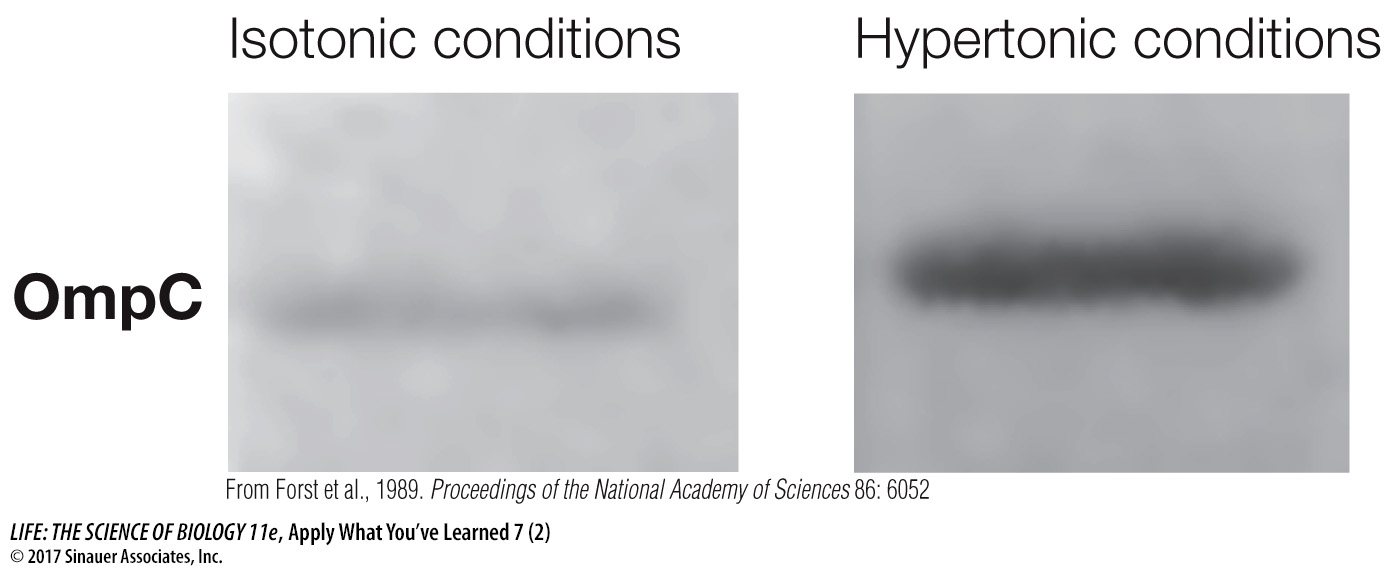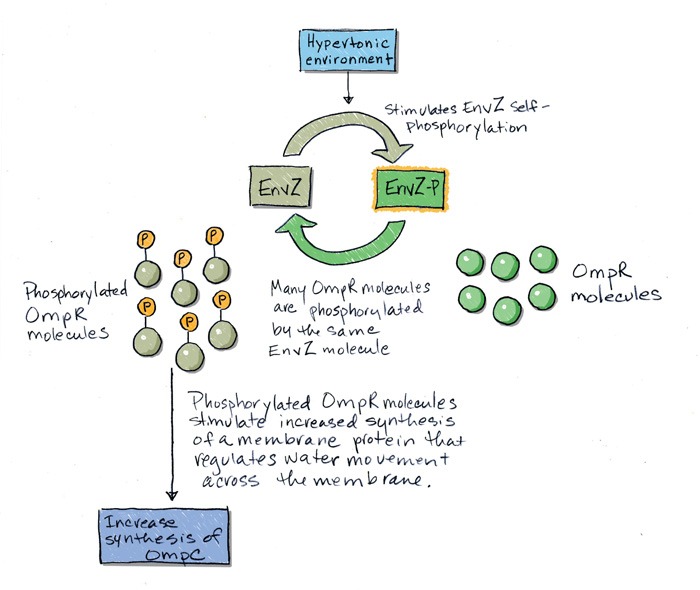Apply What You’ve Learned
Review
7.1
A signal transduction pathway includes a signal, a receptor, and a response.
7.3
A signal transduction cascade transmits and amplifies a signal inside a cell.
Original Papers: Forst, S., J. Delgado and M. Inouye. 1989. Phosphorylation of OmpR by the osmosensor EnvZ modulates expression of the ompF and ompC genes in Escherichia coli. Proceedings of the National Academy of Sciences USA 86: 6052–
Cai, S. J. and M. Inouye. 2002. EnvZ-
Escherichia coli (Figure A) is a bacterium that lives in the human intestine, where it contributes to digestion by breaking down food molecules. You might think that these bacteria have a stable environment, but these microorganisms face a periodic threat. During digestion in the intestine, the solute concentrations around the bacteria fluctuate and at times exceed the solute concentration inside the cells. The cells must respond to this hypertonic environment to prevent desiccation due to water loss.
Figure A

To investigate how the bacterial cells manage this problem, researchers grew E. coli in two solutions. One solution was hypertonic, with a solute concentration higher than that inside the cell. The other solution was isotonic, with a solute concentration similar to that inside the cell. The researchers isolated membrane proteins from the cells and separated them according to size, using polyacrylamide gel electrophoresis. After staining the proteins on the gel, one of the membrane proteins, OmpC, showed differences depending on the environmental conditions used to grow the cells. Figure B shows these results. The amount of stain is proportional to the amount of protein in the gel.
Figure B

The researchers suspected that a signal transduction pathway was involved in E. coli’s response to a hypertonic environment. They investigated whether any proteins became phosphorylated by a protein kinase as part of such a pathway. Interesting results were noted with respect to two proteins: a membrane protein (EnvZ) and a protein found in the cytoplasm (OmpR). After purifying EnvZ and OmpR from E. coli, each protein was incubated separately with 32P-
| EnvZ + 32P- |
OmpR + 32P- |
|
|---|---|---|
| 32P label incorporated into protein | High | None |
Next, the researchers tried mixing 32P-
| Time after mixing 32P- |
||||
|---|---|---|---|---|
| 0 | 2 | 5 | 10 | |
| 32P label present in EnvZ | High | Medium | Low | None |
| 32P label present in OmpR | None | Low | Medium | High |
Finally, the researchers measured the quantities of EnvZ and OmpR in E. coli cells after they were grown under different conditions. Values in Table C are numbers of molecules per cell.
| Nutrient broth (isotonic) | Nutrient broth + 20% sucrose (hypertonic) | |
|---|---|---|
| EnvZ | 63 | 113 |
| OmpR | 2,043 | 3,525 |
Questions
1.
What evidence shows that bacterial cells respond in their membrane protein composition to changes in environmental solute concentration?
The figure shows that different amounts of the membrane protein OmpC are produced and inserted into the membrane, depending on environmental solute concentration.
2.
What do the data in Tables A and B indicate about the roles of EnvZ and OmpR? Write two equations to illustrate your answer.
The membrane protein EnvZ is a protein kinase that phosphorylates itself and then phosphorylates OmpR in the cytoplasm. This sequential phosphorylation could explain how signal transduction occurs in this signal pathway.
EnvZ + ATP → EnvZ-
EnvZ-
3.
What evidence suggests that signal amplification occurs in this signal transduction system?
The numbers of molecules of EnvZ are much smaller than the numbers of molecules of OmpR in the cytoplasm, suggesting that a smaller number of the membrane proteins act to stimulate a larger number of cytoplasmic proteins that carry the signal to the next point in the signal transduction pathway.
4.
Draw a sketch to illustrate a possible mechanism for how this signal transduction pathway responds to a hypertonic environment. Your sketch should account for all of the data provided.
